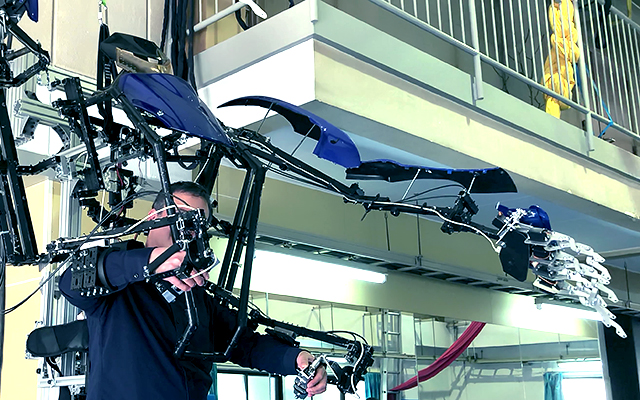
© Skeletonics, Inc.
We Tried The World’s First Consumer Model Entertainment Exoskeleton Suit by Skeletonics
- Source:
- © Skeletonics, Inc.
- Tags:
- consumer model / entertainment / exoskeleton / human function augmentation gear / order-made / Robot / Science Fiction / Skeletonics Inc.
Related Article
-

Gekkan Geinin: The First Monthly Entertainer Photo Exhibition now at Shibuya Parco
-

Get Your Hands On Cool Kazuo Umezu Goods At Limited Online Shop
-

Japanese icing cookie artist fashions amazing Laputian Robots out of sugar
-

Japanese Amphibious Gill Garment Aims To Let Humans Breathe Underwater
-

A Humanoid Buddy In Your Pocket: A Phone That Is Also A Walking Robot!
-

Japanese Robot Dog Powered By Pneumatics Runs As Cute And Clumsy As A Real Pup


Exoskeletons in science fiction and reality: from the Power Loader to powered exoskeletons
If you're old enough to remember the power loader Ellen Ripley (Sigourney Weaver) uses to fend off the xenomorph queen in Aliens (1986), there's a good chance you've harbored a secret (or perhaps not-so-secret) wish to operate a powerful robotic suit that mimics your movements. Anime such as Gundam, Macross, Evangelion, novels like Starship Troopers and recent films such as the Pacific Rim series have also helped fuel our desire to operate humanoid machines that augment the functions of our bodies. In a limited sense, real-world technology has already caught up with such science-fiction imagination in the form of powered exoskeletons for medical, industrial and military applications.
Skeletonics: Exoskeletons for entertainment
Within this emerging field, however, Japanese company Skeletonics Inc. distinguishes itself by creating exoskeletons for recreation and entertainment purposes. Moreover, unlike their powered cousins, Skeletonics Inc. exoskeletons extend the motions of the operator through purely mechanical means thanks to their masterful construction. Their most recent model, the Skeletonics™ Arrive, in its default configuration, stands at over 9 feet tall and weighs a little over 88 lbs. Skeletonics Inc.'s proprietary design in the shoulder of the exoskeleton allows a wide range of arm motion and smooth motion. Moreover, in an improvement over previous models, the Skeletonics™ Arrive allows a user (who has gone through training) to suit up with simple attachments and begin operation in only one minute. Finally, since its parts are detachable, with a bit of practice, the user can take it apart and put it in a box which will fit in the cargo hold of a commercial aircraft.
Skeletonics Inc.'s products (their Japanese term for their exoskeletons, 人体機能拡張ギア translates as "human function augmentation gear") can be used at amusement parks and conventions, or just playing around outside. The thrill of riding around in your very own exoskeleton which smoothly responds to your legs and arms makes for a fun experience. According to their website, Skeletonics Inc. hired a company to do an AI-based emotion analysis using a live camera feed which was installed at an event where people could ride their exoskeletons. As a result, they discovered that 20% of all 437 visitors to the event experienced a feeling of happiness. Interestingly, the number was as high as 42% for women.
Skeletonics™ Arrive order-made consumer model
Source: © Skeletonics, Inc.
We had a chance to operate the Skeletonics™ Arrive last week after the company announced the beginning of B-to-C operations. In other words, for the first time since its establishment in 2013, Skeletonics Inc. was giving the general public an opportunity to purchase one of their products. In its standard configuration, the Skeletonics™ Arrive has a starting price of 10,000,000 JPY (about USD 93,000 at time of writing) before taxes but customized additions such as painting, decals, LED lighting, and additional parts will cost more. More details are explained on their website.
Hands on with the Skeletonics™ Arrive
When we reached the studio where the press event was being held, the Skeletonics™ Arrive was being piloted by a Skeletonics Inc. staff member. Seeing it in photos just can't compare to actually seeing it in operation before your very eyes. As the arms moved smoothly in response to the pilot's movements, it seemed to be more lightweight than we imagined.
Source: © grape Japan
Source: © grape Japan
Although it obviously can't compare with the dimensions of a mobile suit from Gundam, a life-size model of which stands in Diver City, Tokyo, it towers at over 9 feet tall and looks most impressive.
Source: © grape Japan
The arms can move in almost any direction in a natural way.
Source: © grape Japan
Source: © grape Japan
It was very easy to step into the frame and get "suited up" to begin piloting the Skeletonics™ Arrive. The first thing we noticed was that the hands contained five buttons to control the fingers. This is the only part of the exoskeleton which is controlled by electronics, power being supplied by a battery pack attached to the back of the frame. With separate articulation in the fingers, it is possible to clasp and manipulate objects, provided that they are sufficiently lightweight and wide. For example, with a bit of practice, we were able to catch a plush ball thrown by a staff member and throw it back to them.
Source: © grape Japan
Source: © grape Japan
You can see the Skeletonics™ Arrive in motion in their official promotional video:
Overview of Skeletonics Inc. Order-Made Service
.
Development Flow
For more information about Skeletonics Inc., please visit their website here.